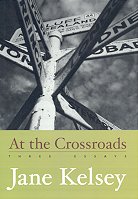No.167 14 June 2002
 BACK
BACK
|

“ If policymakers and politicians began with an image of New Zealand that was built around communities, hapu and families, towns, cities and farms, instead of markets, human capital and "low well-being neighbourhoods" ... the project of nation building, and ideas of inclusion, well-being and partnership, would look very different ...” |
No commentators seriously expect the Labour Party to lose the coming election. The ballot may be, in effect, more of a referendum on whether or not Labour should govern alone.
Yet Kelsey argues that this year is indeed a “crossroads” time ... and she calls for a deeper debate on current economic and social choices.
Kelsey concedes that, under the Labour/Alliance coalition government, aspects of social, environmental and foreign policy have shown some genuine redirection.
But her overall view is that the “Third Way” brand of government is more about “short-term political management rather than transformation”. And it is a political style that enables centre-left governments to claim that they are abandoning neoliberal economic policies while simultaneously stabilising and embedding the conditions for the continuation of the same policies.
Readers may not agree with Kelsey’s analysis — or her recipe of alternatives. But these essays will feed contemporary debate and become an important landmark in commentary on the New Zealand political landscape. — VH
 THESE THREE ESSAYS are well timed for an election year.
THESE THREE ESSAYS are well timed for an election year.
Jane Kelsey, a professor of Law at the University of Auckland, is one of New Zealand’s leading left-wing intellectuals committed to economic and social justice. Her previous books — Reclaiming the Future (1999) and The New Zealand Experiment (1995) — contain a meticulous analysis of the impact on New Zealand of the “new right” political agenda and globalisation. This book of essays summarises her previous arguments, and brings the issues up-to-date for a country about to go to the polls again.
from the book ...
Tariffs were removed from everything except imports on textiles, clothing and footwear in the misguided expectation that vibrant new enterprises would emerge from the ashes of those which collapsed. Speculative finance moved in and out of the country in response to the Reserve Bank’s manipulation of interest and exchange rates, playing havoc with the productive economy and employment.
These changes were systematically locked in through a plethora of free trade and investment agreements. New Zealand made the most extensive commitments of almost any country at the WTO, especially on trade in services.
The Closer Economic Relations agreement on free trade in goods and services with Australia is as sweeping as NAFTA, except that it formally excludes investment. Investment agreements signed with Chile, Argentina, Hong Kong and China between 1989 and 1999 contain NAFTA-style guarantees against expropriation, although their enforcement mechanisms are technically weaker.
These agreements apply for a minimum of ten to fifteen years, with protection for existing investors extending for a further fifteen years after a government withdraws; yet few people even know they exist.
The Labour / Alliance Government elected in late 1999 continued the globalisation agenda, although its rhetoric and strategy became more sophisticated. Globalisation would have a social face, including protections for labour and the environment, and would only be undertaken on a reciprocal basis. There would also be greater consultation with business, unions and ‘civil society’.
Our export growth was dismal. We ranked twentieth out of twenty-five OECD countries on export growth performance indicators. A 1998 survey of forty-five countries showed that New Zealand was one of five to have lost market share over the past six years. The rising level of import dependency led to persistent trade deficits, although the effects of a substantial depreciation provided some relief in 2001.
New Zealand’s net foreign debt, at around NZ$87.1 billion, was well beyond the levels of the East Asian economies at the time of their financial collapse. There was a chronic deficit in the external current account of the balance of payments, mainly due to a sustained net deficit on foreign investment income. That had to be bridged by asset sales, more overseas borrowing, or using up government reserves. The share of the country’s income from domestic production that remained available to fuel the New Zealand economy, after net profits, income and dividends remitted abroad were accounted for, reached a fifty-year low.
New Zealand had done everything globalisation required of it. The result was a pathologically dependent, vulnerable and under-performing economy.
Maori, Pacific Islands and other immigrant families were much more likely to live in poverty than Europeans. Inequality had also grown. The richest 5 per cent of New Zealanders had increased their share of national income since 1984 by 25 per cent, while that of the bottom four-fifths fell. The poorest had proportionately lost most.
The social infrastructure of public health, education and housing had deteriorated and its commercialisation had put such basics beyond the budget of many families.
Privatised telecommunications, electricity, banking and transport were operated for the short-term benefit of their foreign owners, with no obligations to provide affordable access or quality. The regions were increasingly hollowed out from trade liberalisation, privatisation and rural recessions, while the cities were more visibly divided on socio-economic lines.
The fact that similar approaches have been pursued by other ‘centre-left’ governments in countries that experienced radical free-market restructuring in recent years illustrates the effectiveness of structural adjustment politics and the inadequacy of the traditional left, nationally and internationally, to derail that agenda. Third Way political management may successfully defuse the tensions created by globalisation in the short run. But its unwillingness to confront the cause of those tensions will prove politically unsustainable in the longer term.
Giddens believes that technology has so transformed the nature of capitalism and work that historical notions of class have become irrelevant. Indeed, his thesis lacks any theory of politics or power. The government’s principal role is to facilitate the successful globalisation of capital and assist individuals to cope with the consequences through education, training and employment subsidies. Within this environment, citizens are expected to balance their rights and responsibilities, but the owners of capital face no corresponding obligations. The pursuit of consensus, partnership and social inclusion at the local, national and international levels means the Third Way does not disturb any existing interests and has no enemies. Uncomfortable constructs such as class, colonisation, racism and patriarchy can be banished from the political lexicon.
A number of these agencies opposed the accident compensation reform because it would increase the cost of insuring their workers. One branch of the YMCA appeared among the sponsors of an employers’ advertisement that opposed the Employment Relations Bill. As a result, the credibility with which these agencies could mount traditional arguments about social justice, community obligations and employer responsibilities was seriously undermined.
As a result, the ‘fundamentals’ of tight monetary policy, fiscal restraint, trade liberalisation and light-handed regulation were more secure than before. These were also the parameters within which any Third Way initiatives for regional economic development, an inclusive economy and a knowledge-driven society would be framed.
There is a strong sentiment in Third Way politics that these traditional constituencies no longer matter. The formulation of policy and political responses now depends more directly on the regular focus groups, market research and spin doctoring undertaken by governments whose primary concern is to attract the uncommitted voter and get re-elected.
This helps to explain how the officials can talk about inclusion, social cohesion and sustainability purely at the level of individuals. It also allows them to treat the ‘fundamentals’ of deregulation, privatisation, trade liberalisation and Reserve Bank-induced recessions as purely economic, when these are social to their core.
Likewise, they can acknowledge that economic policies such as cuts to benefits and real wages, market-driven education, health and housing, user-charges for essential services or the redistribution of the tax burden have social consequences, but still maintain those policies while offering individualised palliatives. And it enables them to ignore absolutely the contribution of colonisation and exploitive immigration policies to structural poverty and deprivation in Maori and Pacific Islands communities.


